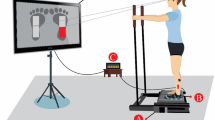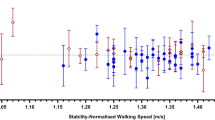Abstract
A number of recent studies have indicated that whole-body coordinated reactions are employed to regain balance following disturbances during walking. However, it is not always the case that all body segments are available to contribute to balance corrective strategies. We hypothesize that balance corrective strategies will adapt to task and environment constraints such that greater responses are generated in the available body segments when other body segments are unable to participate. In this study, we tested the hypothesis that voluntarily restricting the arms during walking would result in an increase in the amplitude of the electromyographic responses evoked in leg muscles when subjects are perturbed at the torso during walking. To do so, subjects were asked to walk on a motorized treadmill while either crossing their arms across their front or back, or with their arms swinging normally. Periodic perturbations, forwards and backwards, were applied at the pelvis randomly throughout the step cycle. This resulted in short latency responses in leg muscles. The amplitude of these responses was increased when subjects walked with their arms crossed, as compared with normal, unrestricted walking. Facilitation of these evoked responses was restricted to the early part of the stance phase, particularly at heel-strike. The pattern of muscle activation and the latency of the responses were not affected by restricting the arms. We suggest that this finding indicates that whole-body balance corrective strategies employed during walking are selected based upon the demands of the general features of the task, but that components of the strategy are scaled according to the specific context-dependent needs of the task.






Similar content being viewed by others
References
Adkin AL, Frank JS, Carpenter MG, Peysar GW (2000) Postural control is scaled to level of postural threat. Gait Posture 12:87–93
Berger W, Dietz V, Quintern J (1984) Corrective reactions to stumbling in man: neuronal co-ordination of bilateral leg muscle activity during gait. J Physiol 357:109–125
Bloem BR, Allum JH, Carpenter MG, Honegger F (2000) Is lower leg proprioception essential for triggering human automatic postural responses? Exp Brain Res 130:375–391
Carpenter MG, Frank JS, Silcher CP, Peysar GW (2001) The influence of postural threat on the control of upright stance. Exp Brain Res 138:210–218
Dietz V, Quintern J, Sillem M (1987) Stumbling reactions in man: significance of proprioceptive and pre-programmed mechanisms. J Physiol 386:149–163
Dietz V, Fouad K, Bastiaanse CM (2001) Neuronal coordination of arm and leg movements during human locomotion. Eur J Neurosci 14:1906–1914
Do MC, Bussel B, Breniere Y (1990) Influence of plantar cutaneous afferents on early compensatory reactions to forward fall. Exp Brain Res 79:319–324
Magnusson M, Enbom H, Johansson R, Wiklund J (1990) Significance of pressor input from the human feet in lateral postural control. The effect of hypothermia on galvanically induced body-sway. Acta Otolaryngol 110:321–327
Maki BE, McIlroy WE (1997) The role of limb movements in maintaining upright stance: the “change-in-support” strategy. Phys Ther 77:488–507
Maki BE, Perry SD, Norrie RG, McIlroy WE (1999) Effect of facilitation of sensation from plantar foot-surface boundaries on postural stabilization in young and older adults. J Gerontol A Biol Sci Med Sci 54:M281–287
Marigold DS, Patla AE (2002) Strategies for dynamic stability during locomotion on a slippery surface: effects of prior experience and knowledge. J Neurophysiol 88:339–353
Marigold DS, Bethune AJ, Patla AE (2003) Role of the unperturbed limb and arms in the reactive recovery response to an unexpected slip during locomotion. J Neurophysiol 89:1727–1737
Misiaszek JE (2002) The effect of restricting arm movements on the amplitude of compensatory reactions of the legs during walking. Soc Neurosci Abstr: Program No. 267.13
Misiaszek JE (2003) Early activation of arm and leg muscles following pulls to the waist during walking. Exp Brain Res 151:318–329
Misiaszek JE, Stephens MJ, Yang JF, Pearson KG (2000) Early corrective reactions of the leg to perturbations at the torso during walking in humans. Exp Brain Res 131:511–523
Sinkjaer T, Andersen JB, Larsen B (1996) Soleus stretch reflex modulation during gait in humans. J Neurophysiol 76:1112–1120
Tang PF, Woollacott MH (1998) Inefficient postural responses to unexpected slips during walking in older adults. J Gerontol A Biol Sci Med Sci 53:M471–480
Tang PF, Woollacott MH (1999) Phase-dependent modulation of proximal and distal postural responses to slips in young and older adults. J Gerontol A Biol Sci Med Sci 54:M89–102
Tang PF, Woollacott MH, Chong RK (1998) Control of reactive balance adjustments in perturbed human walking: roles of proximal and distal postural muscle activity. Exp Brain Res 119:141–152
Acknowledgements
This work was supported by a grant from the Alberta Heritage Foundation for Medical Research (JEM). We thank Drs. D. Collins and K. Fouad for their helpful comments on a draft of this manuscript.
Author information
Authors and Affiliations
Rights and permissions
About this article
Cite this article
Misiaszek, J.E., Krauss, E.M. Restricting arm use enhances compensatory reactions of leg muscles during walking. Exp Brain Res 161, 474–485 (2005). https://doi.org/10.1007/s00221-004-2094-8
Received:
Accepted:
Published:
Issue Date:
DOI: https://doi.org/10.1007/s00221-004-2094-8




